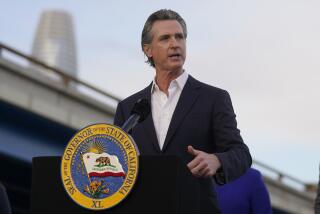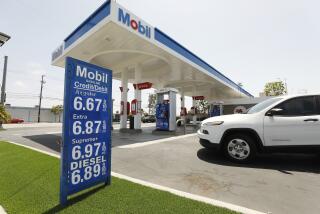Fewer drivers over a barrel
- Share via
Sun Valley legal secretary James Eric Freedner got fed up with high gasoline prices.
He put his 2003 Toyota Tacoma truck in the garage and switched to a Honda Nighthawk motorcycle for weekday commutes to Beverly Hills. He stopped driving to the beach on weekends and cut back on trips to Hanford and Fresno to check on properties he manages. He began grouping errands into one trip each Saturday.
The trade-offs Freedner has made in the last year haven’t necessarily made him happy, but they’ve reduced his gasoline consumption nearly 50%. And although he admits to feeling jittery traveling freeways on the Nighthawk, all the changes are permanent, unless gas returns to $2.50 a gallon.
“The price was just eating up what I earned,” said Freedner, 57. “This is the best thing I can do to make ends meet.”
Americans are getting serious about using less gasoline, confounding some economists who have argued that most people can’t reduce their driving much because they have to get to and from work and make those necessary trips such as shopping and chauffeuring their children around.
The truth is more complicated, according to some energy experts: When the price reaches a certain threshold or the driving reaches a peak point of aggravation, people are willing to give up personal space and independence.
“There is an awful lot of what might be called discretionary driving,” said Edward Leamer, an economist with the UCLA Anderson Forecast. “Raise the price high enough, and you will see that there is a lot more that people can do.”
For some, the next drop in prices won’t be enough to send them back to their old driving habits.
“The trend will be toward more lasting conservation and longer-term savings if they are not just reacting to prices and have instead made a decision to change,” said Bruce Bullock, executive director of the Maguire Energy Institute at Southern Methodist University’s Cox School of Business in Dallas.
In California, the nation’s biggest fuel market, drivers have been burning through less gasoline than they had the year before for six straight quarters. From July through September, the most recent data available, Californians used 46.2 million fewer gallons, or 1.1% less than in the year-earlier period.
Consider ridership figures for the Bay Area Rapid Transit system.
For seven years, nothing was able to displace Oct. 4, 2000, when the San Francisco Giants and Oakland Athletics baseball teams were gunning for a pennant. BART set a single-day ridership record with 374,900 passengers.
That peak was eclipsed in 2007, and has been beaten so often that it no longer ranks among the top 10 ridership days. The new record, 389,400, was set Aug. 31.
Ridership on the buses and trains run by the Los Angeles County Metropolitan Transportation Authority dropped overall in 2007, but officials said that was the result of a fare increase in July. Before that, boardings had been on the rise.
The MTA’s Orange Line has seen daily ridership grow from just under 15,500 in 2005 to nearly 21,500 last year.
In its annual state of the region report, released in December, the Southern California Assn. of Governments noted that the share of commuters who drove alone had dropped in 2005 and 2006, from 76.7% to 74.1%, reversing steady increases from 2000 through 2004.
With gasoline prices doubling since 2003, motorists nationwide are conserving fuel by taking fewer trips, driving slower and paying premiums for the most fuel-efficient vehicles, the Congressional Budget Office said in a recent report.
Kimra Haskell, a mathematics professor at USC, began bicycling to work six months ago.
She had many reasons. Sometimes she felt a shooting pain in her driving leg. She wanted to make a statement about the Iraq war and U.S. dependence on foreign oil. The California lifestyle of driving everywhere for everything -- even to exercise at a gym -- had left her too dependent on her aging 1993 Honda Accord.
She made her trial run from Eagle Rock to USC on a clunky, old Schwinn mountain bike. On the return trip of the 26-mile ride, uphill, she was ready to abandon the bike by the side of the road. But she persevered, bought a sleek, Italian Bianchi Volpe bicycle and is building up to cycling to work five days a week.
Gas prices were only part of the story, Haskell, 43, said. “It was mainly the effects on my health, on the time it took out of my life, the stress of dealing with the traffic.”
Antipollution regulations are altering habits, too. California’s air-quality rules demand that employers with 250 or more workers takes steps to reach a 1.5-1 passenger-vehicle ratio, or about 34 cars for every 50 employees.
At the Jet Propulsion Laboratory in La Canada Flintridge, there are perks for ride sharing. About 8,000 full-time and contract employees work on a campus with only 4,000 parking spaces, said John Miranda, JPL’s employee transportation coordinator.
Drive to JPL alone, and you’ll have to walk a few blocks from an off-site parking lot, Miranda said. Sharing the ride with one person earns an unassigned space on the JPL campus, he said. Three or more to a car hits the jackpot: an assigned parking space on campus.
One who didn’t have to be sold was Shadan Ardalan, 39, who serves as navigator of the Cassini space probe’s mission to Saturn. Mornings and evenings, Ardalan navigates a van pool in a leased Ford, taking co-workers to and from the Redondo Beach area.
“Driving alone was a huge stress, a lot of wear and tear on the psyche,” Ardalan said.
Bad news at the pump has been good for business at Troy, Mich.-based VPSI Inc., which leases six- to 14-passenger vans to businesses, governments and transit agencies.
The company charges $900 to $1,200 a month for the vans, which allow employees to leave their cars at home. Employees with good safety records serve as drivers for their pools.
After averaging between 5% and 6% annual growth for much of its history, Chief Executive Jeff Henning said, VPSI has grown 10% or more on average nationally since 2005. Southern California had the fastest expansion in 2007 at 13%, although it takes extra to entice Southlanders.
Although most of the vans leased by VPSI customers in other parts of the nation are utilitarian at best, California van pools tend to carry more expensive accouterments, such as high-backed, individually reclining seats, said Jim Appleby, VPSI’s manager for Southern California.
“It takes a little bit more to get people out of their cars here,” Appleby said.
Sometimes, the answer can be as easy as changing work hours and offering an incentive.
To encourage carpooling, Hilario Navarro, president of 36-employee Bonanza Foods & Provisions Inc. in Vernon, rearranged schedules of six workers who lived in West Covina. In January, he handed out $100 prepaid gasoline cards to the first two drivers of the month.
Now, there are often just two vehicles on the road to work from West Covina, with three riders each.
But less gasoline guzzling isn’t the only fringe benefit, Navarro said. It has changed the climate of his workplace as well.
“They arrive happier now,” he said, “with more energy.”
--
(BEGIN TEXT OF INFOBOX)
74.1%
Percentage of Southern California commuters who drove alone in 2006
$3.11
Average price in California for a gallon of regular gasoline the week of Feb. 11
389,400
Record for single-day ridership on San Francisco’s Bay Area Rapid Transit system, set Aug. 31
More to Read
Inside the business of entertainment
The Wide Shot brings you news, analysis and insights on everything from streaming wars to production — and what it all means for the future.
You may occasionally receive promotional content from the Los Angeles Times.











